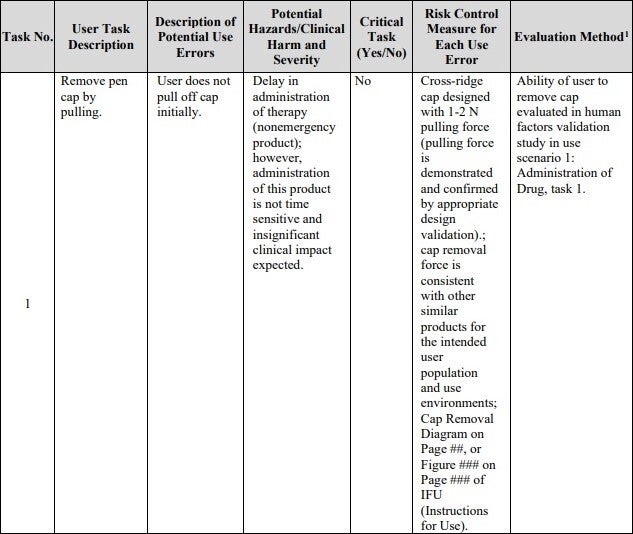July 29, 2024
By Tiffany Yang-Tran and Andrea Dwyer
The U.S. Food and Drug Administration (FDA) issued a new draft human factors engineering (HFE) guidance document, Purpose and Content of Use-Related Risk Analyses for Drugs, Biological Products, and Combination Products, on July 8, 2024. The guidance informs manufacturers of drug- and biologic-led combination products about the purpose and content of a use-related risk analysis (URRA) and how a URRA informs other human factors (HF) activities and can be used to support a marketing application or justification to forgo submitting HF validation study results. The benefit of this new draft guidance is that it organizes and consolidates all risk analysis information into one document. This article summarizes Emergo by UL’s interpretation of the guidance and describes the key content needed for a strong URRA and justifications to forgo submitting HF validation study results.
Conducting a thorough URRA
A use-related risk analysis is a risk analysis tool that helps identify potential use errors and harms associated with a product. Characterizing each risk then helps manufacturers mitigate risks through risk controls, ideally including improved product user interface design. A comprehensive and up-to-date URRA is imperative to the product lifecycle because it serves as the foundation for many key HF activities, such as comparative analyses, HF validation testing and residual risk analysis. The draft guidance states a URRA should include the following components:
-
All tasks required for product use
A comprehensive and systematic list of all tasks (use steps) involved in product use, including tasks related to physical product interactions as well as knowledge tasks related to assessing labelling information.
-
Potential use errors that might occur
A list of use errors/reasonably foreseeable misuse for each task. Common use errors describe a user who performs a task incorrectly or skips performing a task altogether. Various methods can be used to brainstorm these use errors, including but not limited to performing failure modes and effects analysis, fault tree analysis and identifying known use-related problems.
-
Potential harms and severity
A consideration of the clinical impact and severity of harm for each use error based on holistic factors including dosing, treatment urgency, therapeutic urgency and more. Clinical impact should also consider the impact of a one-time versus a repeated use error.
-
Criticality
A categorization of each task as critical or non-critical. For combination products, “critical tasks are user tasks which, if performed incorrectly or not performed at all, would or could cause harm to the patient or user, where harm is defined to include compromised medical care.” (Definition appears in FDA’s guidance Application of Human Factors Engineering Principles for Combination Products: Questions and Answers in Section IV, Q-5.)
-
Risk controls
An identification of the risk controls (i.e., mitigations) implemented to reduce or, preferably, eliminate risks. The mitigations in order of priority by expected effectiveness are: 1) inherently safe design and manufacture, 2) protective measures in the product and 3) information for safety and training (i.e., labeling).
-
Evaluation methods
A description of how the identified risk controls are/will be evaluated (e.g., via formative evaluations, HF validation study).
-
Continually-evolving URRA
The URRA is a “living document” and should be updated throughout all phases of the product lifecycle (e.g., when the user interface is updated, new risks are identified).
The draft guidance includes an example table of how manufacturers may format their URRA (see the figure below), clarifying that it is an acceptable format, but not the only option.

Determining whether HF validation study results need to be submitted
The new draft guidance also describes how a URRA is a backbone in determining various HF data needs in a marketing application, whether it be developing an HF validation study protocol or justifying that HF validation study results do not need to be submitted.
If a manufacturer decides to submit HF validation study results to support a marketing application, they should use the URRA to design an HF validation study protocol that evaluates all necessary risk controls.
If a manufacturer determines that HF validation study results do not need to be submitted, the FDA suggests conducting a comparative analysis, which includes a labeling comparison, a comparative task analysis and a physical comparison between the proposed and comparator product to identify the differences and similarities between the products’ user interfaces and associated risks. Additional rationale should include consideration of items such as intended users, dosing considerations and user familiarity and experience with the product.
The new draft guidance provides several scenarios and indicates if and why (or why not) HF validation study results should be submitted. The examples suggest that it might not be necessary to submit HF validation study results if the proposed device is single-use, single dose (i.e., does not require any dose calculation, measurement, escalation), but it is necessary to submit HF validation study results if the device is only familiar to a subset of the user population, the performance shaping characteristics differ between intended and existing users and/or if the use environment contains stressors or uncontrolled variables. For more information about when and how to develop a strong justification, see our article Core elements of a justification to forgo HF validation testing and webinar Conducting a comparative analysis in lieu of HF validation testing.
Implementing the new draft guidance
The new draft guidance remains in alignment with FDA’s various HFE guidance listed in the guidance’s introduction. While reading and implementing the guidance, consider submitting comments to the FDA by September 9, 2024.
Please reach out if Emergo’s Human Factors Research & Design team can help you develop complete and compliant URRAs and/or compelling justifications for not submitting HF validation study data. You can also sign up for a complimentary account with OPUS™, our digital platform that provides HFE training and templates, including several that focus on URRAs.
Tiffany Yang-Tran is a Senior Human Factors Specialist and Andrea Dwyer is an Associate Research Director at Emergo by UL.
Request more information from our specialists
Thanks for your interest in our products and services. Let's collect some information so we can connect you with the right person.






